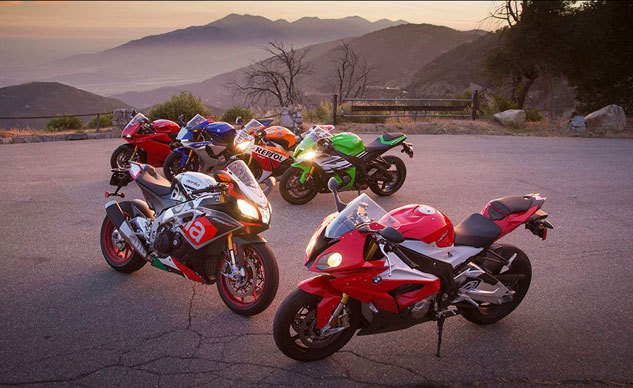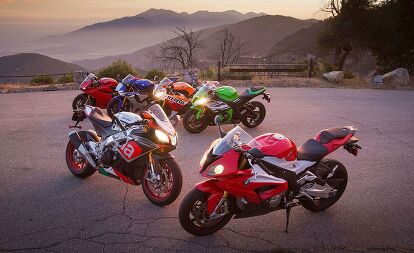How Much Faster Are New Motorcycles Than Older Ones?
Ask MO Anything: How much faster have bikes really gotten?
Dear MOby,
How much “lap time” progress has actually been made over the past 25 years? All the moto outlets are very precise in reporting lap times during the yearly comparison tests, but in the same conditions on the same day, how much faster around a track is a new superbike (pick whatever one is currently considered fastest) compared to say, a 1993 CBR900RR with both ridden by an average rider and then both ridden by a very skilled one?
There have been an awful lot of comparison tests done over the years. I wonder if there’s enough of them done with relevant bikes on similar days with comparable riders. Maybe put the vast MO research department on the job? Lacking that, it sure would be interesting to see a track day with several sportbikes that represented definitive progress points. To wit:
- 1993 CBR900RR
- 1st gen R1
- Ducati 999
- K5 GSX-R1000
- 1st year BMW S1000RR
There’s got to be owners in the SoCal area with stock(ish) old bikes who would like to see how their bikes stack up against the newest ones enough to spend a day thrashing them.
Walter Barlow
Great question, Walter. As a guy who set up and/ or participated in a slew of magazine track comparisons over the years, I have to say there’s really no scientific way to gather and collate all that data. Even if we returned to the same track every year, which was often Willow Springs in the old days but not always, some years it would be cold and windy, some years not. Some years we’re using each bike’s stock tires, some years we’re using a control tire – and there’s never enough time in one day, or two, to adjust suspension and things to make every bike and rider happy if there’s more than one of each. Which is not to say that multi-bike track tests aren’t a good thing for comparing bikes to each other all on the same day, but comparing from year to year is risky business.
For a down and dirty Ask MO Anything, I think the easiest and quickest way is to have a look at World Superbike racing stats, readily available online here, for one place. World Superbikes, of course, aren’t off-the-shelf motorcycles, but they’ve alway been based on them, especially in more recent years. Weather changes from year to year influence race results, too, but WSB has returned to at least a couple of circuits that haven’t changed at all over the years, making things a bit more scientific. As for the riders, as a group they’re the most skilled in the world, nearly eliminating rider skill as a variable – though blood alcohol levels have come down over the years as rider fitness has gone up.
Let’s start in 1990 with Donington Park (in WSB’s first two years, ’88 and ’89, the track was shorter and lap times were in the 1:13s). In ’90, Fred Merkel won Race 1 on his Honda RC30, with a best lap of 1:39.41 seconds, and Giancarlo Falappa (!) won Race 2 with a best lap of 1:38.86, on a Ducati 851. By 1992, Raymond Roche and his 888 Ducati won Race 1 at Donington with a 1:36.77. In ’93, some kid on a Kawasaki named Scott Russell turned a best of 1:35.24 in Race 1, on his way to winning both legs and the Superbike Championship.
In 1996, Troy Corser won Race 1 with a best lap of 1:33.47 on a Ducati 916 – just about 6 seconds faster than Merkel’s lap six years earlier. After that, lap times at Donington seemed to mostly stabilize until it fell off the WSB calendar after 2001. When it reappeared in 2007, after 1000cc Four-cylinders and 1200cc Twins were the new limits, James Toseland on a CBR1000RR and Noriyuki Haga on a Yamaha R1 split wins: 1:31.77 and 1:31.63.
After 2004, you can eliminate tires as a variable since we’re all on Pirellis now. By 2009, our boy Ben Spies won both legs on his R1, with best laps of 1:30.58 and 1:30.63. In 2012, Marco Melandri drops the hammer on his BMW S1000RR, winning Race 1 with a best lap of 1:28.999. Max Biaggi turned an even quicker 1:28.995 in Race 2 on his Aprilia RSV4, but got beat by Johnny Rea’s Honda anyway (1:29.213).
Last May at Donington, Tom Sykes won both legs on a Kawasaki ZX-10R, turning a 1:26.712 best lap in Race 1.
What we’re looking at, then, is about a 13-second faster lap in 17 years – about a 14.6% improvement, which is good but not as good as you might expect given that Sykes’ ZX-10R probably has twice the horsepower of Fred Merkel’s RC30 and much more grip, in addition to electronic aids Fred hadn’t dreamed of.
Phillip Island is another track that hasn’t changed a bit (except for resurfacing) since World Superbike began racing there in 1990. Peter Goddard and Rob Phillis split wins that year, Goddard’s best lap was 1:39.57 on his Yamaha OW-01, Phillis’ best a 1:39.33 on his ZXR750 Kawasaki. Last season, Jonathan Rea won both legs on his ZX-10R, with a best lap of 1:30.17. That’s about a 10% improvement in 17 seasons of racing.
Why the 5% gap between Donington and Phillip Island? Maybe because Phillip Island is a fast, flowing place that tests outright horsepower and grip: Phillis’ average speed in 1990 was 99.3 mph; Rea’s average speed in 2015 was 107.3 mph. At Donington, which requires more braking, acceleration, and direction changes, Merkel’s 1990 average RC30 speed was 89.75 mph; by 2014, Sykes’ average speed had climbed to 100.2 mph.
Your CBR900RR never got to compete, but John Kocinski won the ’97 title on an RC45 and Colin Edwards won in 2000 and ’02 on an RC51. When 1000cc Fours were allowed to compete in 2004, Troy Corser stepped forward on the new GSX-R1000 and won Suzuki its first (and last) WSB title. And Ducati 998s and 999s won tons of races under people like Carl Fogarty, Troys Corser and Bayliss, Neil Hodgson and James Toseland. Nobody stays on top forever, though, and the last five champs have been on Kawasakis and Aprilias. In other words, those 10 and 15% improvements since 1990 are more or less equal across the board; that rising performance tide has lifted all boats.
Subjectively speaking, as maybe an advanced intermediate rider, I can tell you the difference between riding a new ’94 GSX-R1100 around Laguna Seca 23 years ago, and a new Aprilia RSV4 Factory 22 years later, is roughly equivalent to the difference between using XyWrite to write a story and handing it over to the managing editor on a floppy disc versus typing it on a Google Doc to share real-time in the cloud.
Expert riders and professional racers benefit from electronic traction control for certain, but maybe not as much as we non-experts do. On the old GSX-R, I saw Jesus so many times I started using him for a braking marker (thank you Jeff Karr). On the Aprilia (and the BMW and the R1 and the ZX-10R), I barely ever set a wheel wrong, went way faster in spite of being way older, and barely even frightened myself. I don’t think much of that’s raw talent. I think it’s the bike, and I’d put the improvement at much more than 10 or 15% if you’re a non-professional – wait – non-expert rider like me.
Direct your motorcycle-related questions to AskMoAnything@motorcycle.com, though some say we’re better at non-motorcycle-related ones…
More by John Burns


































Comments
Join the conversation
Not a super bike comparison but just for old/new comparison, my last liter bike was a 79 Yam XS11. then had a pause in biking for 20+ years then got a 2008 Kawi Versys 650.
Even with no electronic assists the Kawi feels light years ahead of the Yam in handling. I think it's about as fast up to 100mph too. You might not notice the progress if you trade bikes every few years.
950 lb motorcycles? and soloid rubber tires , i dont think so a full dress fat bob or elctra glide never weighed over 800 lbs very bad information here